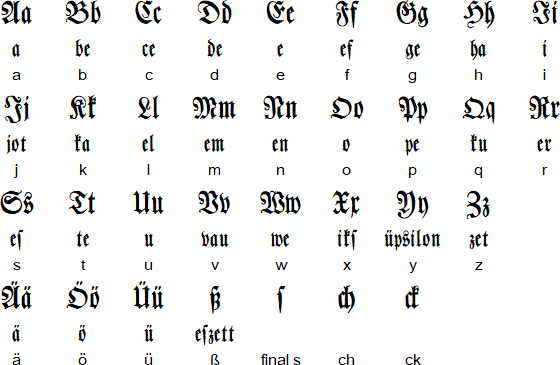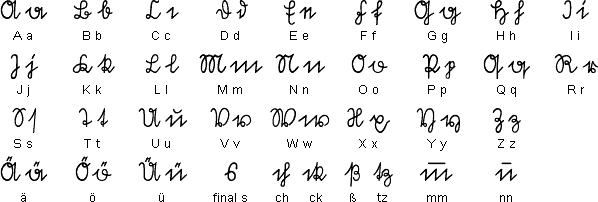German (Deutsch)
German is a Germanic language with about 121 million speakers in Germany,
Austria, Switzerland, Lichtenstein, Belgium, Italy, France, Denmark, Poland,
Hungary, Romania, Russia, Ukraine, Luxembourg, Czech Republic, Slovakia,
Estonia, Latvia, Lithuania, the USA, Canada, Brazil, Argentina, Paraguay,
Australia, South Africa and Namibia.
The earliest known examples of written German date from the 8th century
AD and consist of fragments of an epic poem, the Song of Hildebrand,
magical charms and German glosses in Latin manuscripts. A short Latin-German
dictionary, the Abrogans, was written during the 760s.
German literature started to take off during the 12th and 13th centuries
in the form of poems, epics and romances. Well known examples include
the epic Nibelungenlied (the Song of the Nibelungs) and Gottfried
von Straßburg’s Tristan. The language used is now
known as mittelhochdeutsche Dichtersprache (Middle High German
poetic language). During this period Latin was gradually replaced by
German as the language of official documents.
Varieties of German used in writing
High German (Hochdeutsch)
High German began to emerge as the standard literary language during the
16th century. Martin Luther’s translation of the Bible, which he completed
in 1534, marks the beginning of this process. The language he used, based
partly on spoken German, became the model for written German.
Swiss German (Schweizerdeutsch or Schwyzerdütsch)
A variety of German spoken by about 4 million people in Switzerland,
occasionally appears in writing in novels, newspapers, personal letters
and diaries.
Regional dialects of German, or Mundarten, also occasionally
appear in writing; mainly in ‘folk’ literature and comic books such as
Asterix.
Written German script styles
Fraktur
Fraktur was used for printed and written German from
the 16th century until 1940. The name Fraktur comes from Latin and
means “broken script”. It is so called because its ornamental
twiddly bits (curlicues) break the continuous line of a word. In German
it is usually called the deutsche Schrift (German script).
Fraktur was also used for a number of other languages, including
Finnish, Czech, Swedish, Danish and Norwegian.

Notes
The second lowercase s appears at the ends of syllables, except in the
following combinations: ss, st, sp, sh and sch, while the first (ſ) appears everywhere else.
The symbol ß (scharfes S or Eszett) is a combination of the long s and z,
or a combination of the two types of s: there is some dispute about origin of this symbol.
For further details, see:
http://en.wikipedia.org/wiki/ß.
Sample text in Fraktur

Sütterlin
Sütterlin was created by the Berlin graphic artist L. Sütterlin
(1865-1917), who modelled it on the style of handwriting used in the old German Chancery.
It was taught in German schools from 1915 to 1941 and is still used by the older generation.

Sample text in Sütterlin

| A a | B b | C c | D d | E e | F f | G g | H h | I i | J j | K k | L l | M m |
|---|---|---|---|---|---|---|---|---|---|---|---|---|
| a | be | ce | de | e | ef | ge | ha | i | jot | ka | el | em |
| N n | O o | P p | Q q | R r | S s | T t | U u | V v | W w | X x | Y y | Z z |
| en | o | pe | ku | er | es | te | u | vau | we | iks | üpsilon | zet |
